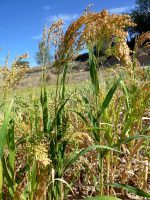
Also known as proso millet, this warm season annual is a member of the grass family, Poaceae, that also includes corn, rice, and bamboo. Archaeological evidence suggests that it was first domesticated in north east China around 8,000 BC, was present in 3000 BC in Mesopotamia, and was used with other grains and legumes for food during famines in biblical times. The ancient Roman naturalist, Pliny the Elder (died 79 AD), tells us that “Campania is particularly prolific in millet, and a fine white porridge is made from it: it makes a bread, too, of remarkable sweetness.” Carbonized plant material of millet was found in the soil of the excavated area in and around Pompeii dating from the time of Vesuvius’ eruption in 79 AD. Photo Credit Wikipedia
Plants are often branching at the base and grow 6″-3′ tall with a stout stem and a spreading fibrous root system. The leaf sheaths have long spreading hairs, but the leaves are smooth or less hairy and 12″ long or more. Spikelets are carried in panicles 3-10″ long from early summer to autumn. The fruit is a grain that is white to yellow, orange or reddish brown, and has a sweet nut-like flavor.
Size: 6′-3′ H
Light: Full sun
Soil: Average, dry to medium moist, well-drained; drought tolerant
USDA Hardiness Zones: NA (annual)